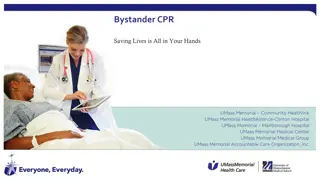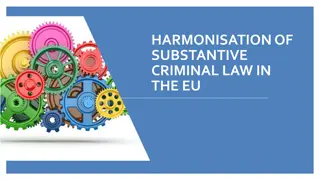European Arrest Warrants and Legal Framework in European Criminal Law
Description of two cases involving European Arrest Warrants - one for theft in Hungary and the other for driving without a license in Romania. The cases raise preliminary questions about the execution of European Arrest Warrants and detention conditions in issuing Member States.
Download Presentation

Please find below an Image/Link to download the presentation.
The content on the website is provided AS IS for your information and personal use only. It may not be sold, licensed, or shared on other websites without obtaining consent from the author.If you encounter any issues during the download, it is possible that the publisher has removed the file from their server.
You are allowed to download the files provided on this website for personal or commercial use, subject to the condition that they are used lawfully. All files are the property of their respective owners.
The content on the website is provided AS IS for your information and personal use only. It may not be sold, licensed, or shared on other websites without obtaining consent from the author.
E N D
Presentation Transcript
European Arrest Warrant European Criminal Law Samuel Schewczuk Slovakia
CONTENT: I. Description of Cases (CrimesCommitted) II. Preliminary Questions III. Legal Framework 1. Framework Decision 2. Principles (of This Framework Decision) 3. Treaties 4. Charter of Fundamental Rights of the European Union 5. Convention of Human Rights 6. German Law (effected by cases) IV. Conclusion Judgment
Case A (Mr. P l Aranyosi C-404/15) Mr Aranyosi is a Hungarian national born on 14 July 1996 in Sziksz (Hungary) District Court, Miskolc, Hungary issued two EAW for the purposes of his prosecution: He was accused of: 1/ having stolen, after breaking into a house (in Hungary), EUR 2 500 and HUF 100 000 (Hungarian forints) (approximately EUR 313) in cash and various items of value 2/ entering a local school, damaging equipment and stealing technical devices and cash of an estimated total value of HUF 244 000 HUF (approximately EUR 760).
He was temporarily arrested on Jan. 2015 in Bremen (Germany) and placed in detention pending extradition. Subsequently: The German judicial authorities (Higher Regional Court Bremen) were asked of a request for the surrender of the person under two EAWs, issued in Nov. 2014 and Dec. 2014 by District Court, Miskolc, Hungary for the purpose to conduct criminal prosecution.
Case B Mr Robert Cldraru (C-659/15 PPU) Mr C ld raru is a Romanian national born on 7 December 1985 in Bra ov (Romania). In Dec. 2013 a suspended prison sentence was imposed on him for the offence of driving without a licence he reoffended (committed the same offence) in Aug. 2014 he was arrested and placed in detention pending extradition in Bremen (Germany) in Nov. 2015 - - - Consequently: The German judicial authorities were askedof a request for the surrender of the person under a EAW issued in Oct 2015 by District Court, Fagaras, Romania for the purpose of execution of a custodial sentence of one year and eight judgment. months imposed by a final
II. QUESTIONS Referring Court Asks: The Higher Regional Court, Bremen decided to stop the proceedings and asked the following questions for a preliminary ruling: (to European Court of Justice) Whether the executing judicial authority: 1/ may or must refuse to execute a EAW when there is solid evidence that detention conditions in the issuing Member State are incompatible with fundamental rights (interpretation of Article 1(3) of Framework decision) 2/ if information about detention conditions may be provided by the judicial authority of the issuing Member State or if the completing of that information is governed by the domestic rules of that Member State. (interpretation Article 5 and 6 of Framework decision)
III. LEGAL FRAMEWORK 1/ Framework Decision - 2002/584/SVV European Arrest Warrants The European arrest warrant = extradition mechanism bulit by principles of - - - cooperation between the national judicial authorities mutual recognition of judgments and judicial decisions and mutual confidence between the Member States. > establishes a new simplified and more effective system for the surrender of persons convicted > constitutes an essential improvement to the prosecution and punishment of criminal conduct within the Union > it s also abolition of the internal borders within the Union.
Article 1 Definition of the EAW and obligation to execute it, provides: 1. EAW is a judicial decision issued by a Member State with a view to the arrest and surrender by another Member State of a requested person, for the purposes of conducting a criminal prosecution. 2. Member States shall execute any EAW on the basis of the principle of mutual recognition and in accordance with the provisions of this Framework Decision 3. This Framework Decision shall not have the effect of modifying the obligation to respect fundamental rights and fundamental legal principles as is established in Article 6. Article 5 Guarantees to be given by the issuing Member State in particular cases provides: The execution of the EAW by the executing judicial authority may respond to to the specific conditions .
Article 6 Determination of the competent judicial authorities, provides: 1.The issuing judicial authority shall be the judicial authority of the issuing Member State which is competent to issue a European arrest warrant by power of the law of that State. 2.The executing judicial authority shall be the judicial authority of the executing Member State which is competent to execute the European arrest warrant by power of the law of that State. 3.Each Member State shall inform the General Secretariat of the Council of the competent judicial authority under its law.
III. LEGAL FRAMEWORK 2/ Principles in Framework Decision The guiding principles are based on 3 principles: 1/ The principle of mutual recognition of judicial judgments Aim: to create a space for cooperation without the need of harmonisation of national laws 2/ The principle of mutual trust between Member States The Court defined that principle as requiring each of the Member States to consider, that all the other States are respecting with Union law, and particularly with the fundamental rights recognised by that law. (presumption) 3/ The scope of the principle of proportionality Individualization of punishment, In general it means that the EU will take steps only to the extent which is necessary to reachthegoal.
III. LEGAL FRAMEWORK 3/ Treaties (TEU, TFEU) founding treaties The Union s objective is to create and develop as an area of: freedom, security and justice - - - free movement of persons fundamental rights of all prevention and the fight against of crime. (TEU, TFEU) > Article 6(1) TEU The Union recognises the rights, freedoms and principles set out in the Charter of Fundamental Rights of the European Union . > Article 6(3) TEU Fundamental rights are guaranteed by the European Convention for the Protection of Human Rights and Fundamental Freedoms (TEU)
III. LEGAL FRAMEWORK 4/ The Charter Human dignity is inviolable. It must be respected and protected. Article 1 Article 4 No one shall be subjected to torture or to inhuman or degrading treatment or punishment. Article 6 Everyone has the right to liberty and security of person. Article 52 Limitation must be provided by law and respect the essence of those rights and freedoms.
III. LEGAL FRAMEWORK 5/ Convention of Human Rights Article 3 ECHR Prohibition of torture Noone shall be subjected to torture or to inhuman or degrading treatment or punishment. Article 15 ECHR Derogation in time of emergency = exemptions / e.g.: in time of war or other threatening Article 46(2) ECHR Binding force and execution of judgments , provides: The final judgment of the (European Court of Human Rights) shall be transmitted to the Committee of Ministers, which shall supervise its execution.
III. LEGAL FRAMEWORK 6/ German Law > Implemented: ,,Law on International Mutual Legal Assistance in Criminal Matters (the IRG shortly) > Under Paragraph 15 of the IRG extradition is possible in case if: (1) there is a risk that the individual will not cooperate with the extradition procedure or the enforcement of the extradition, or (2) there is specific evidence to support a strong suspicion that the individual will obstruct the determination of the facts in the foreign proceedings or in the extradition procedure.
III. LEGAL FRAMEWORK 6/ German Law >Under Paragraph 29(1) of the IRG, the Higher Regional Court will decide , about the legality of the extradition where the individual person has not consented to extradition. >Paragraph 73 of the IRG states: In the absence of a request to that effect, mutual legal assistance and the transmission of information shall be unlawful'.
IV. CONCLUSION BOTH Mr Aranyosi and Mr C ld raru objected to being surrendered to the issuing judicial authorities declared that they did not consent to the simplified surrender procedure. The Public Prosecutor s Office of Bremen asked the issuing judicial authorities to state the name of the establishment in which imprisoned, this being in reference to detention condition which do not satisfy minimum European standards. the persons concerned would be Neither of those authorities could commit itself on that point (sent response) and the Public Prosecutor s Office of Bremen therefore wondered, if surrenders are permissible.
IV. CONCLUSION - Facts > The European Court of Human Rights found that there was a general failures of the Romanian and Hungarian imprisonment systems. > E.g no. 1 : It is established that, in Romania, 10 detainees may be concentrated in an area of 9 m , so for 1 person it is living space of less than 2 m. > E.g. No.2 : The European Court of Human Rights has found Hungary guilty to be in violation by the overcrowding in its prisons in cells they were too small and overcrowded 450 similar cases against Hungary were brought before ECotHR. > The case-law discovered the existence of problems in the imprisonment systems of the 47 Member States of the Council of Europe, including Member States of the European Union.
In BOTH CASES Higher Regional Court of Bremen declared the surrender to be unlawful if surrender to the Hungarian judicial authority, Mr Aranyosi Romanian judicial authority, Mr C ld raru might be subjects to conditions of detention that are in breach of Article 3 ECHR and the fundamental rights and general principles of law as in Article 6 TEU.
IV. JUDGMENT OF THE COURT (Grand Chamber) The Court gave the following judgment: IFthe Executing judicial authority doubts about detention conditions in the issuing Member State: 1./ Executing Court: >must accurately verify whether in the case of surrender to member state will the person be exposed to the risk of inhuman or degrading treatment >must request supplementary information if they have lack of it 2./ The Court Issuingthe EAW: >must send that information within the time limit specified in the request. 3./ The Executing Court must delay its decision on the surrender of the individual concerned until it will get (obtain) the supplementary information. If the existence of that risk cannot be eliminated within a reasonable time, the executing judicial court must decide if the surrender procedure should be brought to an end.
THANK YOU FOR ATTENTION























